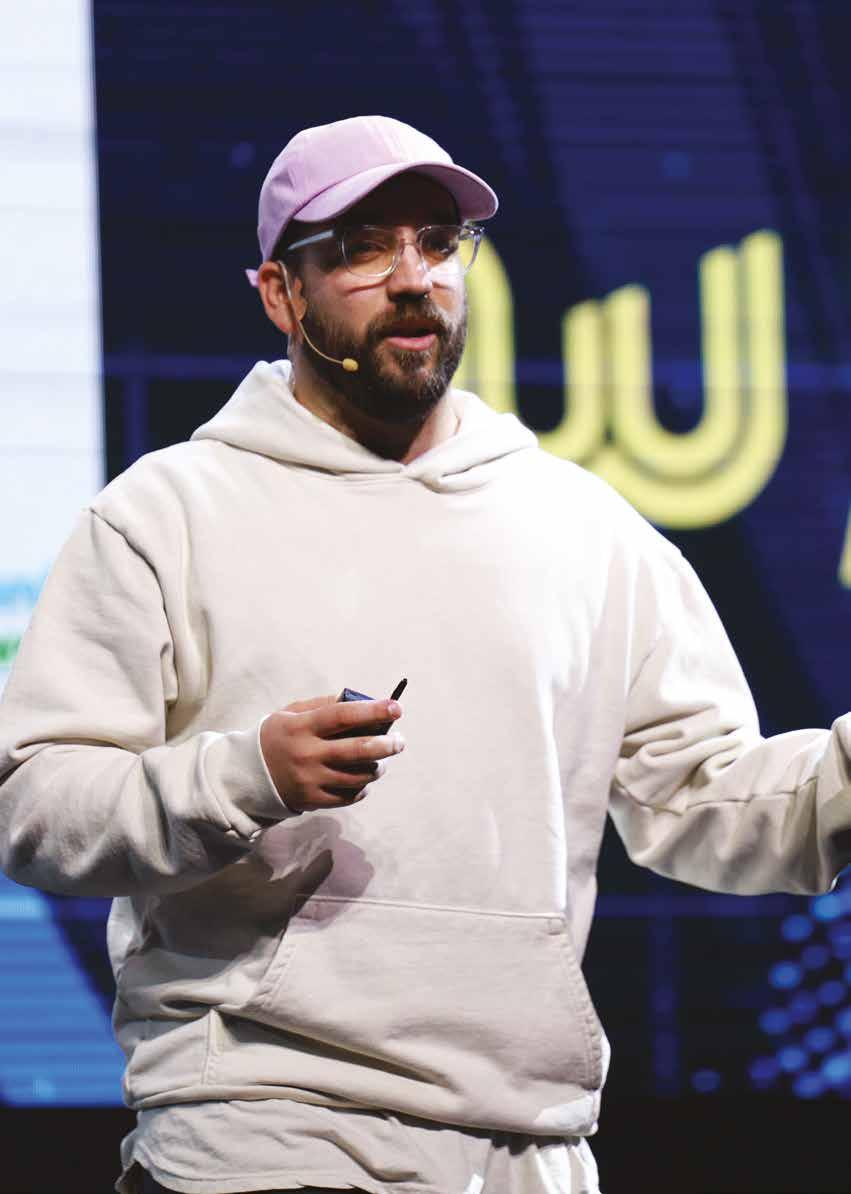
50 minute read
AFFILIATE GOES GLOBAL
Affiliate marketing goes global
2020 will be the year that brands expand their affiliate programmes beyond mature markets like the UK and US and complement their programmes with affiliates in emerging markets – it looks, according to CJ Affiliates at least, as if affiliate marketing’s time has come. And it is all thanks to a global boom in ecommerce.
Advertisement
Mexico, Malaysia and the Philippines are three of the top five biggest risers for ecommerce spend in 2019, with the other two spots filled by India and China. “Most retailers will be aware of the substantial opportunities to be had in mature markets. Dig a little deeper, though, and you’ll find so many hidden gems that are now generating billions in online revenue and many brands are missing out by neglecting them,” explains Jules Bazley, Regional Vice President, Europe at affiliate marketing network CJ Affiliate.
Bazley adds: “Expanding affiliate programmes in markets such as these could have been a risk ten, or even five, years ago, but ecommerce growth of over 30% compared with the year before, have made them the logical next step for marketers.” And the trend is for this to all continue. According to an Accenture and AliResearch report, it’s expected that more than 900 million consumers will shop internationally by the start of 2020, importing $994 million worth of products and services – three times as much as 2015. Increasing access to the internet and accessibility of mobile are major drivers behind the growth in e-commerce spend, connecting those who can’t afford a desktop or tablet, as well as growing numbers of new sellers and region,” says Bazley.
Retailers can launch in a market with little more than a single member of staff on the ground, supported by dedicated companies that have been set up to help them launch in some of the more challenging markets.
“Challenges do remain. Logistics remains one of the biggest barriers to cross-border selling, but it’s not the same problem it once was,” explains Bazley. “Part of the improvement has been linked to increased urbanisation within highly populated areas of Asia and Africa, which has opened more customers up to home delivery.” … and it is all thanks to a global boom in ecommerce leading brands and retailers to look for new ways to target users in new geographies. Paul Skeldon reports secondary industries, adding to market momentum.
Additionally, Salesforce believes that the rise in the need for discounting, coupled with a growing use of AI to allow for personalised ads and offers is what lies behind making all this work and is proving to be a boon for affiliate marketing.
“As a result of more consumers being able to shop abroad, and the ability and willingness of businesses to expand abroad, we’ve witnessed huge demand among advertisers for local market experts, offering the capabilities to recruit publishers in emerging territories and supply granular insight into the potential of each Affiliate World Europe: The place to leverage global ecommerce With the growth in in global ecommerce driving affiliate marketing to new levels, the place to learn how to leverage it – and how to link it to your telemedia and carrier billing offerings – is at Affiliate World Europe (AWE) in Barcelona on 8-9 July.
Happening bi-annually in Asia and in Europe, Affiliate World is the largest performance and ecommerce marketing mastermind you’ll ever experience. More than 3,500 of the top performance marketing professionals from around the globe attend for enhanced networking opportunities and above all, key takeaways to increase profits. In just four short years, it has grown to become what Neil Patel considers “the absolutely mustattend event in the industry”. Bringing together advertisers and traffic sources with brands and agencies – covering TikTok, Facebook, Google, Uber, Onnit, Doordash, Rappi, Lyft, Alibaba, Shopify, and many others.
At the show, you will network with the industry’s brightest minds, absorb mastermind-level content on stage, and be exposed to an exhibition floor overflowing with opportunities to push your career forward.
After each day, you’ll head out for evenings stacked with patio happy hours, rooftop sunsets, and industry nightlife that seems to never end.
THE BIG GUY Paul Skeldon paul@telemedia-news.com ART DIRECTOR Victoria Wren victoria@wr3n.com CONTRIBUTORS & CONSULTANTS Tony Pearce, Victor T Miller, Rory Maguire, Nick Lane, John Strand, Sofia Alves, Bruce Pharoah, Paul Dunone, Jarvis Todd, Sheldon Johns, Mark Birkett, Eric Feltin, Tim Green SALES & MARKETING info@Telemedia-news.com PRODUCTION DIRECTOR Annika Micheli annika@Telemedia-news.com PUBLISHER Jarvis Todd jarvis@Telemedia-news.com TO SUBSCRIBE www.TelemediaOnline.co.uk CIRCULATION ENQUIRIES Geraldine Lawton - O’Sullivan Geraldine@Telemedia-news.com WHAT WE’VE BEEN LISTENING TO It’s Always Been You, Ray LaMontagne Fuctifano, Peter and the Test Tube Babies WHAT WE HAVE BEEN READING Collected works, Carl Jung WHAT WE HAVE BEEN AMUSED BY Man like Mobean WHO WE’VE BEEN FOLLOWING The Red Hand Files, Nick Cave SPRING 2020 WILL BRING… Brexit
TELEMEDIA MAGAZINE is published five times a year and circulated in print to qualified readers and downloaded in digital format to 12,000+ requested readers. BUSINESS ADDRESS: Ground Floor, Virginia Cottage, Nash Lane, Scaynes Hill, West Sussex, RH17 7NJ, UK. Web: www.TelemediaOnline.co.uk Overseas subscriptions and non qualified readers can obtain Telemedia Magazine with an annual subscription rate of £15 / E20. Refunds on cancelled subscriptions will be provided at the publisher’s discretion, unless specifically guaranteed within the term of subscription. © World Telemedia Ltd. All rights reserved. No part of Telemedia Magazine may be reproduced or transmitted in any form or by any means, electronic or mechanical, including photocopying and recording on any information storage or retrieval system without the written consent of the publisher. The contents of Telemedia Magazine are subject to reproduction in information storage and retrieval systems. Repro and Print by Trio Offset
Direct carrier billing – the payment tool that fits the bill Paul Skeldon. editor non-gaming apps monetising via subscriptions, with video and dating categories propelling app store spend as adoption of Tinder, Tencent Video, iQIYI, and YouTube climbs.
While there is a move towards subs, there is also a move to one-off payments for access to some services or one-off access to content, again consumed on mobile.
Taken together this is a very powerful new paradigm – and it needs a new way for consumers to easily pay.
Carrier billing fits this bill perfectly. It is quick and easy to use from a consumer point of view and, despite some reservations in some markets, it is now well tried and tested.
However, there is way more to carrier billing than just pleasing consumers. Here in the era of GDPR and PSD2, in Europe at least, carrier billing offers the least consumer data-centric way to pay on mobile.
It also comes with built in spending limits per day and per month… something that the UK’s gambling companies are likely to view with renewed interest now that the Gambling Commission has banned the use of credit card (see page 6).
In fact, the more you look at the way the consumer market for media and content has shifted, the more carrier billing suddenly fits the bill. www.telemediaonline.co.uk @telemediaTweets Has direct carrier billing’s time finally come? It looks like it might. Mobile is now the definitive device for consuming content and services for the majority of users across Europe and the world (see page 1).
The State of Mobile 2020 report from App Annie, finds that annual global consumer spend via the channel likely to reach $380 billion driven by effective mobile ads, games, retail and video.
Mobile is the place for OTT music, TV, films and more. It is also creating a wealth of new services from hiring electric scooters to paying for bus tickets to paying to charge the device itself.
Subscriptions contribute to 95% of spend, says App An nie, with three out of four top
BOLD.Pay is a cloud based multi-channel payment access that enables dynamic billing arrangements to be executed on multiple formats such as mobile, web and in-applications.
Supports various channels
A digital technology company based in Asia enabling digitalisation platform as-a-service in the areas of Notification, Engagement and Payment.
2020 vision: what lies ahead for telecoms

John Strand has been predicting the future of telecoms for 24 years – and as 2020 gets going, he doesn’t disappoint. Here are some of the key issues facing the telecoms and telemedia industry this year
Telecoms is a fast evolving business and, as 2020 roars into life, there is much set to happen this year – from 5G roll out to Chinese equipment supplier mistrust, to personalisation to privacy issues, it is all to play for. So what is going down in 2020?
THE MOBILE OPERATOR’S CLASSIC BUSINESS MODEL IS PROBABLY DEAD AND BURIED Most of the world’s mobile operators have evolved their business model in face of competition and revenue erosion by OTT players. Mobile operators have realised that revenue from traditional streams of voice, SMS, and MMS is in free fall. In 2020 the industry will see a new direction in which operators divide into infrastructure companies and service companies.
We believe that this split comes in many forms and models. We think we will see companies that make a classic split, but we also think that we will see companies that will make more creative splits in which divesting masters and towers is just the first step. We expect this trend could translate to spectrum. We envision an industry divided into three elements: infrastructure, services and spectrum.
Such fragmentation will require a new view of spectrum and it ownership and use. When it comes to spectrum sharing, dynamic spectrum sharing will open several new technical possibilities. To see the future spectrum market, look at the introduction ofCitizens Broadband Radio Service (CBRS) in USA, a model likely to spread and which is creating a new value chain and dynamic market. Many new and exciting companies have already entered and created equipment and services. This is the same dynamic underpinning the introduction of premium SMS, MVNOs and in connection with the app industry that has emerged at the top of the smartphone universe.
Of note is massive rollout of 5G and fixed wireless access (FWA) solutions. If 5G is hot in 2020, then 5G/FWA will be super-hot in 2020. Strand Consult’s forthcoming report on 5G/FWA will show how fixed line providers can extend their service and revenue with 5G. The business and economics of this development follow a similar dynamic to the MVNO market, and customers can reuse this knowledge from Strand Consult.
5G LAUNCHED WITHOUT A GREAT VISION 5G is coming faster and stronger than 2G, 3G or 4G. With each new G, implementation and adoption time gets shorter. However, regulators in many countries are failing to keep pace
with the technology, as they are behind on frequency allocation and rollout policy.
Indeed, few regulators have succeeded to make infrastructure rollout more efficient or auctions more quickly. The pressure is on the Federal Communications Commission (FCC) in 2020 to deliver an auction for the C-band so that the US can stay in the global 5G race and correct for the misguided history of handing out frequency to government users without accountability measures in place.
Strand Consult has worked on these problems for years and notes that it is still too difficult and expensive to roll out new network in most countries. In Denmark Strand Consult has helped to reduce total annual rental costs for mobile masts by about 20%. In most countries, 5G will be first marketed as an alternative to fixed line broadband. Wireless solutions based on 5G will help stimulate competition. The performance of most EU countries on 5G is disappointing.
Countries which used to lead the world in mobile standards are nowhere to be found with 5G. Unless the EU reverses course on its anti-investment telecom policy, don’t expect to see the EU lead in 5G or any other G in 2020, 2021, 2022, 2023 or for that matter in 2030.
Like 4G, most of the value in 5G will accrue to players other than the telecom operators providing the networks. In 4G, most of the value went to smartphone makers and over the top service (OTT) providers such as Google, Facebook and Apple. In most countries, ARPU and earnings for mobile operators have fallen year after year—even though the speed and quality of mobile networks have increased.
Strand Consult would like mobile operators to focus on how partnerships and creative business models can use 5G to create value for their shareholders. Mobile operators have had successful revenue partnerships with premium SMS to develop the service market and MVNO brand strategies to reduce their sales and marketing costs. Operators need to look at these models to find partners for 5G.
OTT, IOT, AND ALL THE OTHER SERVICES Already with 5G, we see the world moving to the over the top (OTT) providers and when it comes to Internet of Things (IoT). This creates a challenge for how mobile operators can engage in partnerships and business models.
The big question is whether it will be a market that will be dominated by classic mobile operators or by MVNOs like Cisco IoTand Wireless Logic that offer corporate clients one stop shopping. Unless mobile operators are smart, they will relegate themselves to dumb pipes again.
heavily on the problem of Chinese equipment in telecommunications networks. While the media has largely focused on Huawei, the discussion should be broadened to the many companies that are owned or affiliated with the Chinese government including but not limited to TikTok, Lexmark, Lenovo, TCL, and so on. The Chinese propaganda machine has succeeded in misleading many media outlets, particularly with the unchecked claims that Huawei’s products are technologically superior. Few media will dare to publish an analysis comparing the operating tactics, the debate about security will become more holistic to encompass the many elements of security including software, vendors, and risk management. The need for network security can be traced through telecom network policy. Strand Consult documents that already in 2005 restrictions were placed on Chinese technology for the 3G rollout. It is telling that the current US President defends European technology companies Ericsson and Nokia while many European operators defend their Chinese suppliers. It will be interesting to see whether
conditions foreign companies get in China compared to the favourable treatment Chinese companies enjoy abroad.
Moreover, there are little to no critical articles investigating Huawei’s role to suppress human rights in China. The vast majority of stories about Huawei start with the company giving an exclusive interview to a friendly, Chinese-speaking journalist in a leading medium which is then syndicated globally.
Too many have a naïve view of the China debate and have not considered the ramifications of turning over key technologies to the autocratic country, not to mention the risk for the telecommunications industry and its customers.
REGULATION WILL HIT TELECOM OPERATORS AGAIN IN 2020 The need for greater security in networks and removing vulnerable elements will hit operators in 2020 with new standards for resilience. While Huawei likes to spin that restrictions on its equipment are mere trade war
the new European Commission will finally ”walk the walk” and demand the same safety and security standards of Chinese companies that European, US, Korean and Japanese firms have had to uphold in EU.
NET NEUTRALITY Net neutrality or internet regulation was invented by the OTT players to cement their business models and provide reduced, if not, free delivery of traffic for the largest platform companies. OTT companies funded many non-profits to conduct global marketing campaigns to overwhelm regulators with millions of comments.
It is telling how many countries in Europe, Latin America and Asia have had net neutrality policy in place for years with nothing to show for it. The policy has not produced locally made innovation or an increase in infrastructure investment. There is an important case study in the FCC recognizing a mistake and reversing it. The FCC realised that the heavy-handed 2015 policy did not deliver the intended
effects and thus removed it and restored the proper role of the competition authority to police anticompetitive practices on networks. Notably in the more than two years of Restoring Internet Freedom in the US, investment has boomed, internet speeds have increased, and the pace of internet startups has not slowed down.
2020 should be the year that policymakers come clean and admit that net neutrality regulation is not working to deliver investment or innovation. Telecom regulators should make policy that incentivizes the best new technologies in networks, not freezing in place obsolete architectures from 40 years ago. In any event, it makes no sense to create network policy which rewards the richest companies such as Google with free transit when they can afford to pay for their use of telecom networks.
PRIVACY: EU, US AND THE REST OF THE WORLD The drive for online privacy regulation worldwide reflects distrust and disappointment in the large platforms, however regulation, however well-intended, can have the opposite of the intended effect. 2020 will mark the two-year anniversary of the General Data Protection Regulation (GDPR) in the European Union.
EU policymakers promised that GDPR would bring a level playing field. Instead the opposite has happened; the largest platform companies have increased their market share and revenue in the region. In some two decades of successive data protection regulation in the EU, small and medium sized internet companies have failed to grow, and consumer trust online is at its lowest point ever, according to Eurostat.
Ongoing reporting by Politico shows how large players have gamed the system and how European data protection authori



ties have difficulty enforcing the rules.
TELECOM COMPANIES WANT TO BE ‘WOKE’ In the coming year, there will be a continued drive to make everything green, and telecommunications is no exception. The future will favour those firms that can build environmental value into their business. Telecom companies can either purchase Guarantees of Origin (GOs) from their energy providers or enter into power purchase agreements (PPAs) with green energy providers.
The first solution does not increase the supply of green energy and is thus “greenwashing”, while the second model is the true green solution. In Denmark, Google has already shown the way by purchasing solar cell capacity from Better Energy A/S.
Telecom companies should investigate these solutions.
They also need to address the lack of women in the industry. Unfortunately 2019 was not the year which marked more milestones for women achiev
A NEW APPRECIATION FOR THE ROLE THAT TELECOM COMPANIES PROVIDE FOR SOCIETY In 2020 security of telecommunications networks will become a key theme in policy circles.

ing leadership in the industry. Of the 25 board members of the global industry association GSMA, just three are women. Notably, two of the three are American. Moreover, the heads of most telecom regulatory authorities are men. Only the US has succeeded to deliver the first and only woman for the Director role at the International Telecommunications Union.
Whereas regulators in the past overwhelming focused on low prices and ubiquity, people will come to appreciate that security is also important and worth paying for. This may evolve into new regulatory obligations for mobile operators, like the network requirements for first responders and national security users. The human rights discussion will also be broadened to
network equipment and other technology providers. In Europe and in large parts of the world, the focus is on protecting a democratic social model where freedom, freedom of expression, privacy and human rights are important elements.
Europe attempts to focus on the rights of citizens, including data protection, and many want to preserve a role for technology to improve the quality of life and add value to our society. In a dictatorship like China, technology is instrumental for the state to fulfil its goals, regardless of whether it improves quality of life or promotes human rights. It will become increasingly difficult for European policymakers to defend the use of many Chinese technologies which violate EU rules.
John Strand runs Strand Consult
The next generation app platform.
App enable your voice, messaging and transactions
Meet us for a demo at WTM, Marbella









Say goodbye to ad campaign optimisation… let machines do it for you
Digital ad campaigns need to be individual and they need to yield results. Is it time to hand over the creation and tracking of ad campaigns to smart machines? Maxime Chevallon, thinks it is and explains how it works
Digital ad campaigns are now more intricate than ever. Not only are advertisers dealing with myriad ads in different formats, but the publisher network is also constantly expanding and it is challenging to assess whether each of your ads are performing as well as they should be. Every advertiser wants their campaigns to yield the best returns at every opportunity. Yet, keeping track of the performance of each and every ad is a monumental task. However, as with many other aspects of modern business, sophisticated machine learning is beginning to take away the ‘heavy lifting’ from advertisers to enable seamless, automated ad optimization. One particular tool driving this intelligent ap
proach to performance marketing is Cost Per Acquisition (CPA) Target bidding - an emerging bid type that automatically optimizes the campaign’s bids based on its conversion rate.
AN INTELLIGENTLY AUTOMATED APPROACH Today, advanced machine learning algorithms power CPA Target tools to identify the best segments, as well as the best bid for each impression, by intuitively adjusting to traffic performance changes on the fly. If a traffic source (specific ad placement on a specific website) meets the target set by the advertiser, bidding is continued automatically to achieve the maximum number of conversions with minimal effort from the campaign owner.
This can also work in reverse; if the source doesn’t meet the goal, bids are automatically lowered or the traffic source turned off completely if the performance doesn’t improve. When compared to the more traditional CPM model, the dynamic nature of CPA Target can work to protect an advertiser’s budget which might have previously been lost, as well as eliminate all time spent on making manual bid adjustments.
The potential for machine-led ad optimization to revolutionise the way advertisers enhance the performance of their campaigns is clear, with automatic adjustments aiming at maximising the number of conversions while minimising cost. There are however some key considerations to be had before this technology can be utilised with the most effective return. There are two critical phases to a successful CPA Target campaign.
MOVING THROUGH THE PHASES The first being the learning phase, which enables the optimization algorithm to find the best performing segments and the exploitation phase, which pinpoints the good performing segments to exploit the campaign and bring the maximum number of conversions.
As its name suggests, the learning phase is very much a process of trial and error at the beginning of any campaign. Like any machine-based algo
rithm, CPA Target solutions are only as intelligent as the data with which they are fed. This process, therefore, requires demand-side platforms (DSPs) to put their algorithms into action, giving them time to analyse their network traffic sources and make effective automated bids based on each campaign’s specific requirements before exploitation can begin.
Once successfully optimized, this highly intuitive approach can both maximise efficiency and ROI for advertisers.
However, the time spent on getting algorithms up to speed can be seen as a barrier to CPA Target’s effectiveness, particularly to advertisers that want instant profits gained from their ad investment. During the stage of optimisation, the observed average conversion costs per segment could initially exceed the target, as algorithms adjust their logic when analysing traffic sources.
For brands wanting to navigate the world of programmatic with the most effective results, a certain degree of risk is therefore ultimately required in order to unlock the true value that machines can deliver for their ad campaigns.
A SMART WAY TO SCALE The responsibility, therefore, falls on DSPs to build a technology that both instils trust among advertisers from the outset and leverage the power of machine-based learning in order to deliver strong ROI for customers as quickly as possible and at scale. Guiding advertisers through this process is paramount, to ensure best practices are followed and that they receive the most return on their ad spend.
For example, once targets are set, it is important that advertisers aren’t tempted to change
Consumers prefer email over any other marketing channel Despite the improvements in digital advertising, let’s not give up on some of the ‘old fashioned’ forms of marketing. For instance, email. According to consumers surveyed in the ‘Consumer Email Tracker 2020’ report from the DMA, supported by Pure360, reveals that email remains the most popular channel across a range of contexts and the number of people that prefer email is almost twice as much as any other channel: 46% stated this compared to 26% for post, and 24% for either text or faceto-face.
In late 2019, consumers estimated the number of emails they receive, on average, as 54.9 per week to their personal inboxes, down from 73.3 in 2017. Around half of respondents (56%) also believe more than half of these emails are marketing messages from brands.
However, despite the importance and preference for the channel, just 13% of people said that over half the emails they receive are useful to them. The most cited reason for unsubscribing from a brand also remains receiving too many emails (57%).
“It’s clear from our findings that email remains at the heart of brands’ ability to communicate with customers, but they also highlight key areas where marketers can improve, such as relevancy and frequency of contact,” said Tim Bond, Head of Insight at the DMA. “Whether they’re considering a purchase, have just made one or need some help, our latest findings showcase email’s ability to help brands engage across the customer journey.”
Komal Helyer, VP of Marketing, Pure360, explains: “What’s clear is that email marketing remains core to the multi-channel experiences available to brands. These latest figures highlight how consumers believe email to be the best channel in a range of different contexts, and as a marketing communications channel, it continues to provide brands with a unique opportunity to create valuable and meaningful experiences for consumers.”
Content-wise customers like a clear transactional link behind the marketing emails they receive, such as discounts or offers (65%), email receipts (59%) and advanced notice of new products/services or sales (43%). In other words, customers are looking for practical content that’s able to facilitate their interaction with brands.
The main reasons given for signing up to receive emails from a brand echo this, with ‘Discounts & offers’ (48%) coming top. However, loyalty also clearly plays a role, as simply being a regular customer already (43%), being sent email receipts (40%), or joining some form of loyalty programme (40%) are also key drivers. Helyer concludes: “Offering recipients more control on top of balancing frequency and relevance could be a trend we see growing over the next few years, further cementing email’s position as a powerful communication channel that has a variety of applications when it comes to customer engagement.”
it often, particularly in the learning stage when they may not necessarily see the best results. A pragmatic approach to setting campaign conversion targets is also crucial. By setting the real value - either industry standards or metrics they have already experienced for user acquisition - advertisers can be assured that they are getting the best performing traffic for each of their campaigns.
Elaborate smart-bidding tools now present across the performance marketing sector, like CPA Target, have the power to achieve this; enabling marketers to fully automate the entire campaign optimisation process - from analysing traffic sources and blacklisting to measuring overall performance. But how can such powerful tools be used most effectively? Successful digital ad campaigns are built on three core pillars; conversions, scale and value for money. Any automated technology powering these campaigns must therefore help brands to meet these goals with minimal interference from the team. Combining smart bidding technology with vast modern networks, traffic sources and supply partners, advertisers are able to set their value and automate full campaign exploration.
Not only does this find the best performing sources
automatically, but allows advertisers to scale their campaigns quickly and ensure the most effective conversions in less time.
When it comes to leveraging revolutionary technologies such as AI and ML in new ways, there are bound to be a few teething issues. While there is still a long way to go before these technologies reach their full potential across the digital ad ecosystem, advertisers who take the steps towards intelligent campaign bidding are better poised to succeed in an automated world.
Influencers verses Advertising How has consumer mindset changed the way we buy?
Advertising is still a force to be reckoned with, but the rise of social media has seen influencers become at least as effective in raising awareness. But how do they compare when it comes to reaching audiences and monetising services? Fran Prince explains
Our screens are filled every day with an array of adverts tempting us to spend, spend, spend – but in an era when consumers value a more personal experience, is the power of the traditional paid ad coming to an end?
With thousands of retailers competing to advertise their products on almost every platform we view, it’s natural that they are looking for new ways to get their messages across. And that’s where the power of influencers comes in.
Current trends show a shift in the consumer mindset, with people wanting to feel part of a community and to have a more customised experience, both of which fuel their shopping behaviour.
Amelia Neate, an expert from the agency Influencer Matchmaker, has warned that while ignoring ads has become easier than ever for potential buyers, influencers - equipped with personality and creativity - are the sales tool every retailer should invest in.
ARE SOCIAL MEDIA ADS REACHING THE RIGHT AUDIENCE? With Facebook and Instagram
having a combined worldwide active monthly user pool of three billion, they are the obvious go-to platforms for advertising.
And, as we know, Facebook and Instagram tend to select advertising content based on a person’s activity and preferences. Those adverts are driven by data, whether that is location, demographics, interests, liked pages or behaviour.
But this personalised targeting can be irritating - In fact, 49% of consumers have reported they find brand-created ads “annoying or irrelevant”. “The issue for advertisers is that many of us will never have set our ad preferences or don’t regularly update this information on our social media platforms,” says Amelia. “Therefore, there’s no guarantee that brands are really reaching the right audience. So, just how relevant are those advertisements?”
An influencer’s audience has already established an interest in the content they are posting, explains Amelia, making them a powerful tool.
“Influencers can understand their audiences on a deeper level, through polls and con-
stant communication. Their followers don’t feel like they are being ‘sold’ to - they feel connected with and valued by that influencer and therefore are more likely to buy a product on their recommendation.”
DATA PRIVACY CONCERNS ARE PUTTING PEOPLE OFF ADS With the ability to use online location services to target ads to households, adverts can spark concerns over security, with many consumers believing they are being listened to through their devices.
For example, while one household member may have expressed an interest in a certain product online, their flatmate or other half may also receive the same advertisement without having even looked at it online.
All that has happened is that the platform has targeted the advert based on location.
“As consumers are becoming more concerned with controlling their online data and identities, they are more adverse to being targeted with sponsored content and obvious advertisements,” says Amelia. “Influencers have gained trust and authenticity and are more discreet with product placement, even though they must disclose gifted or paid content.”
TRUST IS ONE OF THE MOST IMPORTANT FACTORS “Adverts on social media can have a reputation for being too salesy. They often highlight a sale or use terminology like ‘great offers’ and ‘buy now’, plus they are listed as sponsored right away so they are instantly recognisable as an advert.
Trust is one of the most important factors in the buying process. All adverts must adhere to the Advertising Standards Authority (ASA) guidelines and, although influencers must declare all paid for or gifted partnerships, they are still more persuasive than adverts.
Offering a ‘human’ element to promoting a product helps to make them more relatable, natural and less obvious, even with the use of hashtags such as #gifted and #AD, says Amelia.
Influencer Matchmaker recently partnered Amazon Handmade with inspirational TV personality and mum Stacey Solomon. The Loose Women regular, known for
her down-to-earth personality and family values, filmed a video – which featured on her Instagram Stories - where she prepared her home for Christmas with the company’s handcrafted items.
Targeted at like-minded mums looking for something special and more personal, the campaign reached more than 2.6 million followers and sold out many of the featured products. “Stacey is a relatable person whose honest and humble personality matched the messaging behind a hand-made and personalised Christmas,” says Amelia. “Putting the items in situ, in a real home with real people did more than any advert could.”
ADS STRUGGLE TO STAND OUT “There’s a psychology to scrolling on your phone on
social media. Within your feed a familiar face or filter (from an influencer account) will encourage you to pause while ads may appear to look like junk content if the image isn’t grabbing or recognisable. “Platforms are also constantly adjusting algorithms so it’s hard for businesses to keep up. Add to that the competition with other retailers as well as image and text restrictions, then your messaging can easily get lost,” said Amelia.
“As influencers already know what works best with their loyal viewers, the content a brand is ‘putting out there’ with them is instantly going to be more engaging. They can tell a brand’s story in a creative and individual way and ensure consumers are part of that journey.”
CONVERSATIONS WITH AN AUDIENCE ARE KEY The key to successful selling is audience interaction. Pages and posts that generally don’t see any engagement and, more specifically, comments are seeing less and less attraction. The same goes for advertisements. “Audiences build a friendship with the influencers they follow,” says Amelia. “Many of them ask for and give advice and opinions to and from their followers, which prompts a conversation and shows an interest in them as people.” Retailers need to start meaningful conversations with their consumers which can’t unfold easily through digital advertising. Robert Lockyer, a retail expert in the luxury retail sector, said: “We’ve seen a shift in what retailers want to promote via their social pres-
ence. Consumers are connecting with and repeatedly buying from brands that share the same values as them.”
Amelia added: “It is clear that consumers are more intuitive these days. Purpose is fastbecoming the most important factor when choosing to buy from a brand and while ads are also only active for the paid period you choose to promote them, influencers drive lasting brand awareness and should be a go-to marketing method. “Influencer marketing is proving to be more effective and more targeted than digital advertising. Retailers must leverage influencers to get in front of potential customers and affect purchase decisions.”
Fran Prince is from Champions UK
Problems? Problems with AIT’s? Problems with payments? Problems with your current provider?

You need to speak to us! Digital Select Ltd, an established UK network that will have the solutions to your needs!
Tel: +44 (1) 1603 949494 Email: Info@digital-select.com • UK Premium Rate Numbers • IVR, API’s & Bespoke Builds • Great AIT record & AIT resolutions • Real time online stats • Flexible payment terms • Dedicated account managers

Personalised marketing: is the Holy Grail within reach?
Wanting to market to individuals has long been the dream of marketers. Mobile brought that a step closer. Now, thanks to that and technology advances the Holy Grail is within our grasp. Adhish Kulkarni explores how close we are and what benefits it will offer telemedia
inform what happens next: The right offers to present, the most attractive price options based on historical behaviour, and even the orchestration of the next customer. And yet…despite the presence of this treasure trove of the raw material required for effective personalisation, many CSPs still find themselves using only the most basic set of data attributes; time, channel and segmentation variables to drive their communications with and persuade their customers to act. The million-dollar question (and it is, literally, that) is why is this the case?
The evidence suggests that the reason is because creating a unified customer view that informs an effective customer engagement framework, as well as a roadmap for personalised marketing success is, you guessed it, anything but easy. Dynamic commercial conditions require agility allied to efficient processes to drive a quick turnaround for omnichannel campaign activity.
Unfortunately, disparate data sources, unwieldy legacy systems, internal power struggles, siloed organizations and sometimes unclear commercial priorities and KPIs all mitigate against building solutions that drive fast and timely access to abundance of options can not only lead to satisfaction but also to confusion. Counterintuitively, the breadth of the new industry menu has driven a scarcity of clarity. That can only be resolved by pursuing trust and attention in both directions.
Carriers need to provide it to their customers via the manner in which they communicate with them. In return, customers will give their trust and attention back to brands they feel a human connection with. To do that, CSPs must create unique and personalised propositions that foster a special feeling that reflect the uniqueness of each customer. Today, expectations have changed. Customers want to be treated as individuals by empathetic brands that know them and recognise their tenure and the on-going financial commitment to the relationship. They are actively looking for personalised, value-adding and frictionless experiences that make their lives easier and help reflect their values and priorities. But to do this - to meet and exceed customer needs and expectations – CSPs must make far more effective use the component pieces sourced from their loyalty programmes, retail footprint, archives, call To point out that personalisation has long been the Holy Grail of marketing is to say nothing new. Long before digitisation was a twinkle in the most optimistic technologists’ eye, the quest to personalise marketing communications, albeit at a cost in those days, had been identified as a key route to commercial success.
Thus, it comes as no surprise that with the digital era now upon us, Communications Service Providers (CSPs) in particular want to tap the advantages afforded by personalised offers and experiences for their customers more urgently than ever before. The trouble is, in attempting to do so they’re consistently coming up short. Why? There’s no shortage of the data needed to fuel individualised offers. Plenty of that can be sourced via loyalty programmes, in-store behaviour, apps, websites and other sources. Whenever and wherever there’s a customer interaction - be it checking the latest data bundle or Spotify offer, looking for the newest devices, reviewing time left in ae contract or double-checking the last six month’s bill, CSP’s subscribers are providing priceless information to their operators. It’s this information, when harnessed, that can effectively the rich customer profiles that inform relevant, desirable, and meaningful value propositions. If the above situation is the reality many telecoms operators find themselves facing, the good news is that it needn’t be the case. Recent advances in technology have now removed any excuse to operate in this way. AI, Advanced Analytics, Omni-channel engagement platforms, Predictive Targeting, Dynamic Segmentation tools, Digital Next Best Offers and real-time, contextual marketing platforms are available, and they are enabling marketers to take a much more nuanced approach to outreach activity. This means that surprising, delighting and engaging customers at a level more effectively than ever before, and at a fraction of the cost and time than has traditionally been the reality, is not only possible but is fast becoming table stakes for those who aspire to be market leaders. Tapping into the new dawn of personalisation solutions is absolutely critical. In a world of endless noise hallmarked by fierce competition and the availability of almost unlimited information, the customer is overwhelmed by choices. CSPs are pushing more content and products than ever before. The
centre logs, transaction and search histories, revenue management and websites despite the fact that all of these are likely stored in different applications designed to support different functions.
The key is the implementation of a unified platform into which all data can be fed and from which that data can then be accessed, managed by multifunctional teams who have shared objectives and incentives, who possess deep customer understanding and who, armed with advanced analytics, financial resources and decision rights, will be in the best position to tailor the offers, price policies, messages, channels and go to market strategies that the customer actually wants; and that he or she is most likely to respond to in order to maximise impact and commercial results.
At Evolving Systems, our years of experience in this area and the expertise we’ve acquired as a result has led to the development of platform technologies that have been able to dramatically increase the commercial performance of our telecoms clients. They have moved from relying on last generation customer engagement platforms and insight led, real-time approaches to true one-to-one marketing campaigns.
One leading European CSP was able to reduce postpaid and prepaid churn within its targeted and participating customer base by 24% and 28% respectively, to achieve a 19% improvement in overall conversion rate and increase its open rates by 60% and digital (app) usage by 100% as a direct result of using our technology.
In another embattled environment, our client has been able to improve the CPS’s commercial performance by leveraging our Digital Next Best Offer algorithm to increase the revenue of targeted customer base by 6%.
It seems obvious to point out that this approach, not to mention results like this, are the future. CSPs must immediately focus their marketing efforts on developing a unified database that combines information from disparate sources then pairs it with advanced analytics capabilities, AI powered decision engines and a variety of Machine Learning Algorithms. Only when this happens will CSPs be able to score, rank-order and select the Best Contextual Offers for each individual customer, in real-time, on multiple channels

and across multiple selection strategies.
For those smart enough to invest in better understanding of their customers and deploying such an approach, the future is extremely bright. The delivery of the Holy Grail of a truly personalised customer journey and brand experience is, finally, within reach. But to grasp success will require confronting deep-seated assumptions, old company structures and mindsets, and the barriers inherent in legacy environments. CSPs should, however, be consoled by the reality that the storm always comes before the calm and the calm, commercially, puts a very bright future within reach.
Adhish Kulkarni is SVP and GM, Digital Engagement & Loyalty Solutions, Evolving Systems

Why roaming still matters in a 5G world
5G changes a lot, but not everything. While 5G security is a big step forward, vulnerabilities and risks still abound, especially when it comes to roaming. Gunter Reiss explains
Why roaming? Because GTP, the legacy protocol that provides interconnect between multi-generational network interfaces, is inherently vulnerable. And as we’ll see, multigenerational networks –2G through 5G and beyond – will remain on the scene for quite some time, long into a 5Gexclusive or single-generation mobile technology universe ever comes about — if ever.
FIRST, A BIT ABOUT GTP GTP (GPRS Tunnelling Protocol) is a 2.5G technology that enables mobile users to roam seamlessly between networks of different generations. The protocol was developed alongside GPRS (General Packet Radio Service), the mobile data standard integrated into GSM that allows mobile networks to transmit IP-based communications to external networks. As a 2.5G technology, GTP was not developed with security in mind because, before the advent of smartphones, mobile networks had few, if any, security issues. The proprietary technologies within what was then a largely closed industry made for mobile network infrastructures that were virtually “attack-free.” As the industry developed and IP-based technologies came to the fore, the need to secure GTP-enabled interconnections became critical, as evidenced by the increasing exploitation of GTP-exposed interfaces left vulnerable to attacks.
Mobile subscribers and operators alike are impacted, as cyber attackers tap into mobile communications to steal network information and subscriber IDs, which, in turn, can lead to service disruptions, customer churn, and fraud.
ROAMING IS ON THE RISE The elimination of international roaming charges and the skyrocketing number of applications, mobile subscribers who travel, and devices both smart and “stupid” (e.g., IoT and IIoT) has led to exponential growth in roaming traffic — as much as 95% according to Telecoms. com. Billions of smartphones accessing mobile broadband and permanently roaming IoT devices with limited functionality and little or no security are driving mobile data traffic sky high.
According to a recent Ericsson Mobility Report, such traffic, moving across almost 7 billion cellular devices connected worldwide today, is forecast to increase four-fold by 2025. And with next-generation infrastructure support for new device types and new use cases, the growth of international roaming traffic is expected to accelerate even more — Juniper Research predicts a 32-times increase by 2022.
AS ROAMING INCREASES SO DO THE RISKS As the volume of roaming traffic continues to grow, so do the risks. What’s at stake are new and emerging 5G-enabled mobile network revenue streams. To capitalise on the opportunities, mobile operators will need to solve security challenges unique to 5G environments and today’s hyper-connected networks. In the 5G era, security will become an increasingly complex endeavour as the roaming ecosystem grows and becomes more diverse, opening
to a broader range of partners. With industry-specific Mobile Virtual Network Operators and IoT solution providers coming on board, mobile operators will find themselves confronting a security model built on aging protocols such as GTP rather than robust security. Cyber criminals are sure to see the potential of such a booming, yet vulnerable, target, and direct their hack and attack activities accordingly.
THE PERSISTENCE OF MULTI-GENERATIONAL NETWORKS HEIGHTENS THE RISKS Multi-generational mobile networks will exist long into the foreseeable future, which means that GTP will continue to be relevant in a 5G world. As with earlier generations, 5G introduces new standards. However, new standards do not replace the previous ones, but rather, they overlap. So, if earlier generations remain operative, old protocols and their vulnerabilities will threaten networks, 5G or not. Mobile roaming has also changed radically over the course of the industry’s evolution.
Today, more than 2,000 global partners participate in a web of interconnections supporting four generations of mobile technology through dozens of interfaces and protocols. As the industry moves to 5G, with significant overlap of 3G and 4G, new services and technologies will enlarge the attack surface.
GTP-BASED ATTACKS GTP is a communications protocol, not a security standard. As such, it facilitates the flow of data within and between mobile networks, while leaving vulnerable network interfaces exposed to exploitation. GTP vulnerabilities make it easier for attackers to gain access to critical network and subscriber information, including key identifiers such as the Tunnel Endpoint ID (TEID — a pathway into the network’s mobile core assigned by the GPRS Tunnelling Protocol — GTP), the Temporary Mobile Subscriber Identity (TMSI), and the International Mobile Subscriber Identity (IMSI).
That’s everything an attacker needs to impersonate a legitimate subscriber and breach a mobile network. Using such information, hackers can pilfer confidential data to commit fraud, overload networks, drop subscriber communications, and launch denial of service (DoS) attacks. Subscribers are often careless about protecting their smartphones and they expect to use their mobile devices and access all of their services on the road, especially now with recently enacted “Roam Like at Home” rules whereby people pay domestic prices for voice calls, SMS, and mobile Internet while travelling across the E.U. Plus, constantly roaming IoT devices are often unsecured. It all adds up to an environment that makes GTP-based attacks easier and more prevalent. For more information about the types of attacks enabled by GTP
While 5G security is a big step forward, mobile networks will continue to be exposed to GTP threats. So mobile operators will beed to deploy GTP firewall protection against attacks
Here’s how: • Brute Force (aka trial and error) – Using automated, brute-force tools, the attacker sends messages with arbitrary TEID values to the packet gateway until one proves successful. Then, again with brute force, the attacker captures the victim’s TMSI by passively scanning for it with the help of an eavesdropping device (e.g., an IMSI catcher — a rogue or fake base station). With the TEID and TMSI the attacker can send an identification request to the Mobile Management Entity, which will respond with the victim’s IMSI. • IMSI Theft – Here, an attacker takes advantage of legacy 3GPP mobile standards that don’t require networks to authenticate devices and uses an IMSI catcher to steal the IMSI from an unsuspecting subscriber. The lack of authentication makes it relatively easy for an IMSI catcher impersonating a legitimate base station to capture the info needed to launch attacks. vulnerabilities, download the eBook: Smart Phones and Stupid Devices — Why Roaming Still Matters in a 5G World.
5G BEEFS UP SECURITY — BUT IS IT ENOUGH? 5G architecture provides several important cybersecurity enhancements, including encryption, mutual authentication, integrity protection, privacy, and availability. Nevertheless, security will still be needed to protect against 2G, 3G, and 4G multi-generational threats during the transition to 5G. New 5G specifications cover security procedures performed within the 5G system, including the 5G core and the 5G New Radio. Key 5G cybersecurity enhancements include a new Security Edge Protection Proxy that provides additional protection against known inter-exchange/roaming vulnerabilities. 5G also enables network operators to steer home customers to preferred visited partner networks to enhance the roaming experience and prevent fraud.
While 5G security is a big step forward, mobile networks will continue to be exposed to GTP threats. So mobile operators will need to deploy a GTP firewall to protect against attacks coming in from access networks, roaming partners, and IoT to support uninterrupted operations for their networks and subscribers.
PROTECTING 5G INVESTMENTS With its high data rates and massive scale, 5G is raising the bar on the demands placed on operator networks. By enabling mobile broadband and ultrareliable, low-latency communications, the technology will deliver the customer value needed to support long-term industry growth and profitability. However, massive 5G investments will remain at risk without the ability to protect customers, infrastructure, and mobile operators. Fortunately, most mobile operators are aware of 5G security challenges and are taking a proactive approach to addressing them, as evidenced by a recent survey sponsored by A10 Networks.
GTP FIREWALL To fully capitalise on 5G opportunities, mobile operators need to ensure GTP security. GTP firewall protects the mobile core against GTP-based threats such as information leaks, malicious packet attacks, and DDoS attacks through GTP interfaces, providing the security and scalability needed to support uninterrupted operations. It leverages the latest standards and technologies to reduce vulnerability and prevent attacks, ensuring better mobile experiences for customers and a more profitable future for mobile operators.

Offer the new Class 4 VoIP softswitch applying Swiss precision to telecoms services n Ensuring Selected Routes Are Always Profitable n Monitoring Traffic Performance At All Times n Routing & Filters Maximise Quality & Profit n Rapid Price Management & Flawless Invoicing n Tailor-made Installation n Includes exclusive IPRS features to control and analyse real time traffic whilst preventing fraud info@callcom.ch | www.callcom.ch | +41 91 225 8330 NOW ALSO IN PAY PER USE MESSAGGIO
MESSAGGIO is technology and cost effective B2B supplier for DCB and Business Messaging. We provide direct connections to 50+ carriers and to the messenger apps. Highload Multichannel Messaging Platform messaggio.com provides enterprises for One-Time Services (OTP,2FA,A2P) as well as for interactive marketing campaigns. Scalable and developer-friendly traffic processing system enables customers to verify codes, authenticate users, send any kind of notifications and boost customer engagement at low costs.
Email: info@messaggio.com | Tel: +356 99991117 messaggio.com
info@securemt.co.uk
WWW.SECUREMT.CO.UK
+44 (0) 207 058 0200


Secure MT provides card payment processing for online and retail businesses, whether that be for one off payments, wallets, pay for view or subscription services.
ENTERPRISERED
EnterpriseRed offers tools and support to help organisations protect themselves from cybersecurity threats. We provide products and services to help businesses identify, understand and mitigate risks from their technology, people or processes, including specialist software solutions from cybersecurity industry leaders, vulnerability assessments, penetration testing, employee training and access to Managed Security Services.
Contact: sales@enterprisered.com | +44 203 371 9178 www.enterprisered.com
23804 DMWF global advert.qxp_23804 13/01/2020 09:27 Page 1 ADVERTISE IN THE LEADING DIRECTORY FOR THE TELEMEDIA INDUSTRY. CONTACT JARVIS FOR RATES ON +44 (0)7711 92 70 92 MAKE SURE YOU CAN BE FOUND
GLOBAL
28 – 29 MAY 2020 BUSINESS DESIGN CENTRE, LONDON


A FORWARD-THINKINGCONFERENCE EMPOWER THE AMBITIOUS, NEW AGE MARKETER
2 DAYS 100+ SPEAKERS 4 TRACKS
SAVE 20% WITH THE CODE: TELEMEDIA20!
We are seasoned mobile billing experts in Africa’s emerging economies MobiPay is our mobile billing solution incorporating: Content Management System Single API integration Billing gateways Subscription portals
Click to Buy Click to Subscribe Direct Carrier Billing Premium SMS
info@mobivate.com +44 207 267 5222 www.mobivate.com










contact@preferredtelemedia.com
Dynamic Mobile Billing is a global provider of mobile and payment solutions including:
Direct Carrier Billing Bulk Messaging SMS Billing Voice Short-codes Voice Number Ranges Virtual Mobile Numbers
www.dmb-uk.com Tel: +44 (0) 808 206 0808 Email: sales@dmb-uk.com
International Premiums is a worldwide telecom media services Provider and Aggregator.
International Premiums has acquired the sole distribution rights for Albania, Burundi, Central African Republic, Comoros Islands, Congo, East Timor, Guinea, Guinea Bissau, Guyana, Liberia, Tonga, Morocco, Poland, Sierra Leone, Somalia, Vanuatu offering the HIGHEST Payouts with monthly, biweekly and weekly payments.
e : info@interprems.com w: www.interprems.com
Send Verify Numbers Analyse Pay
www.messagecloud.com | sales@messagecloud.com HQ phone: +44 (0)3301 130 243
DREAM JOBS - DREAM TALENT SINCE 1998
Thousands of talented performers ready to work! Hundreds of fresh new job seekers with photos signing up weekly!
SEXYJOBS.COM
Premier Operator Supplier

Adult chat | Tarot chat | Clean chat | VOIP | Live stream moderation | Fully managed 24/7 | Worldwide team | More info on www.text121chat.com
CINEEBOOK is a new type of entertainment that combines the advantages ofbooks and movies.



www.Cine-Books.com business@cine-books.com
ORIGINAL & CUSTOM MOBILE CONTENT in BRAND NEW MEDIA FORMAT
#BILLING
Atlas Interactive provides you with a unique international portfolio of Web, SMS and Voice billing solutions.
The Atlas Groups global presence allows you to monetize your content and internationalize your business all over the world Billing solutions and media applications in +120 countries: 3 Web billing 3 PSMS 3 PRS and IPRS 3 Full payment Platform 3 IVR Platform 3 Service numbers 3 Media Consulting
Please contact our sales team P: +44 (0) 208 779 8700 E: contact@atlasinteractivegroup.com W: www.atlasgroup.bm

Supports various channels
+ Direct Carrier Billing + Credit Cards + Online Banking (FPX) + E-Wallets + Over-The-Counter
#MEDIA MARKETING
Software Solutions For Performance Marketing And Compliance
info@veneoverwatch.io
veneoverwatch.io info@venedash.io

venedash.io

UK numbers
VoIP, PBX outbound dialler
PRS/IVR & call handling Call centre grade PBX for resellers
International premium rate numbers
Payment & number hosting solutions
+44 (0)207 058 1000 INFO@TELECOM2.NET WWW.TELECOM2.NET


www.kwak-telecom.com e-mail: sales@kwak-telecom.com phone: +357 220 223 18 kwak. „LINKING TELECOMS AND MEDIA THROUGH INTERNATIONAL PREMIUM RATE SERVICES“
CORE TELECOM
Core Telecom is the UK’s leading provider of UK Numbering solutions. A fully independent network operator since 2005, we offer unprecedented carrier network accessibility across the globe. With over 35 years of industry experience we can find the right solution for you.
#SUPPORT SERVICES



A UK VOICE NETWORK info@digital-select.com

Nr 1 for Micropayments The Preferred Partner of Carriers, Content Providers and Media
Industry leader since 1992
• Fully integrated Micropayment Platform

• Covering 120 countries with PSMS and PRS
• More than 25 exclusive IPRS terminations
• Direct bilateral agreements to secure traffic

• Unbeatable access and coverage


EXPO• CONFERENCE• NETWORKING
• SPs & Aggregators
• VAS & App Developers
• Payment Providers
• Content Owners
• Publishers
• Merchants & Brands
• Affiliate Networks
• Performance Marketing
• Media Groups
• Ad Agencies
• Fraud Specialists
• Cyber Security Experts
• Social Media Networks
BILLING
€449 Includes all parties, conference sessions, 24 country updates, lunch and access to a worldwide network that generates huge volumes of minutes, messages and traffic
CONT ENT The secrets to engaging and commercializing ‘connected consumers’ whilst they interact with VAS, apps and premium content propositions.




